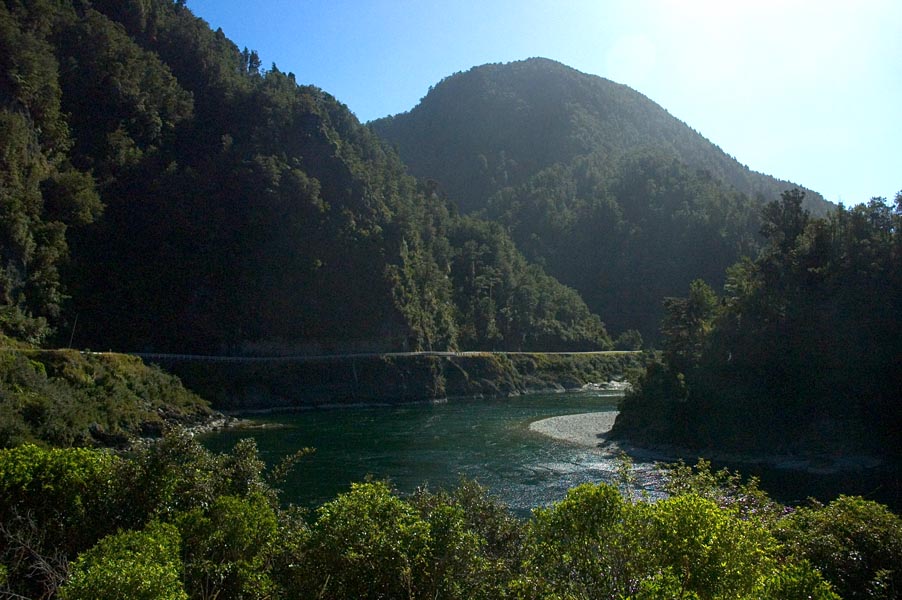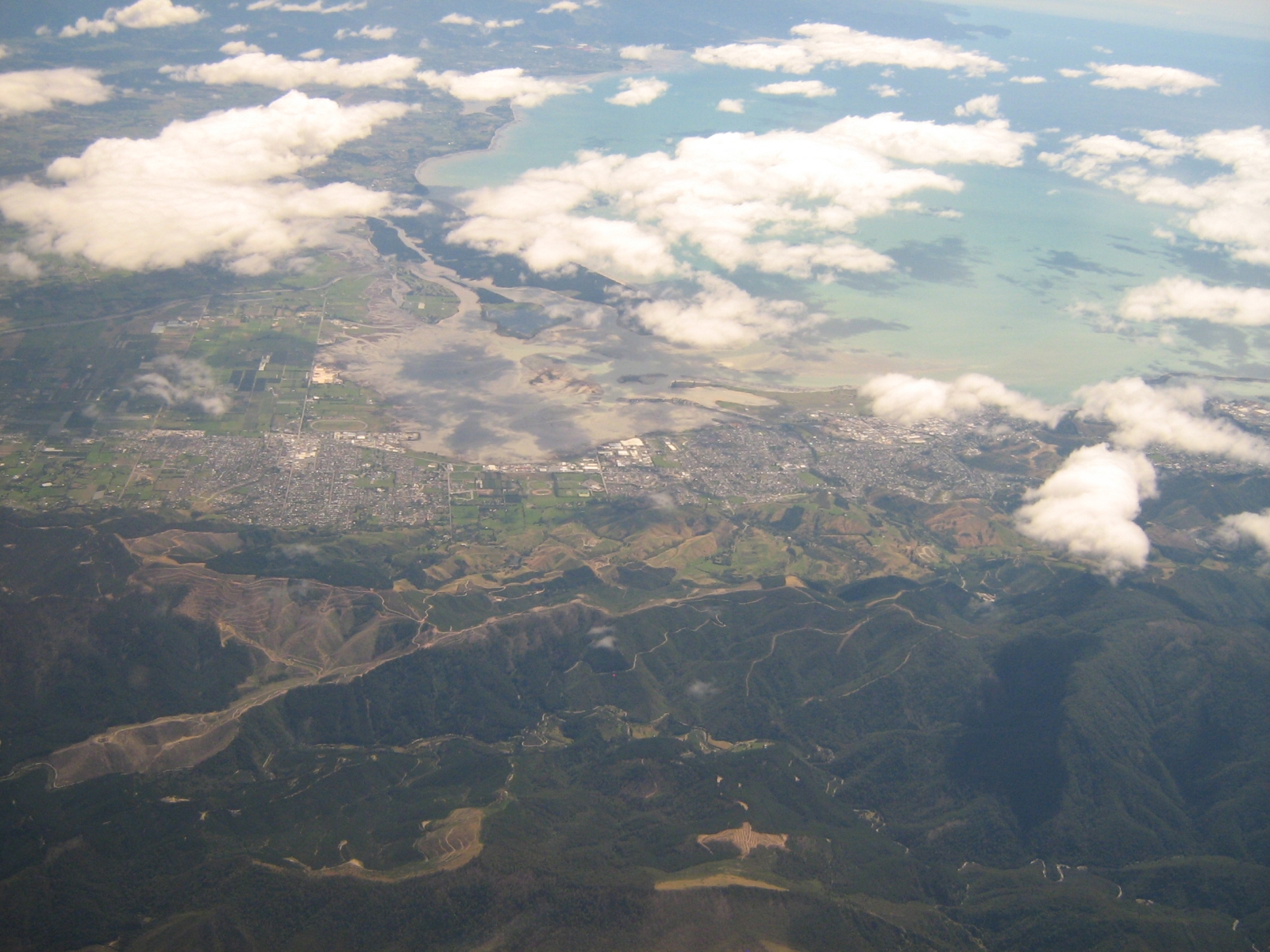|
State Highway 63 (New Zealand)
State Highway 63 (SH 63) is a state highway located in the northern parts of the South Island of New Zealand. It is 117 km long and runs between the settlements of Renwick (in Marlborough) and Kawatiri Junction (in the Tasman region) via Saint Arnaud, providing a bypass of the city of Nelson. Despite being a convenient link between the West Coast and Marlborough, and being a relatively straight highway along most of its length, it is only classified by the NZTA as a secondary collector highway. Route SH 63 begins just to the east of Renwick at SH 6, and parallels the course of the Wairau River for 93 kilometres, initially to the south of the river before crossing to the north side about 20 km from the Marlborough/Tasman border, while passing through the settlements of Wairau Valley, Hillersden and Tophouse. Just before reaching Tophouse, the Wairau River veers to south while the road arrives in St. Arnaud at the shores of Lake Rotoiti. After St. Arnaud the r ... [...More Info...] [...Related Items...] OR: [Wikipedia] [Google] [Baidu] |
Renwick, New Zealand
Renwick is a small town in Marlborough, New Zealand, close to the south bank of the Wairau River. It is located on , west of Blenheim. Havelock is north. State Highway 63 runs southwest from Renwick through the Wairau River valley. The town was initially known as "Upper Wairau", and then as "Renwicktown" after an early landowner, Dr. Thomas Renwick. Renwick is located in the centre of Marlborough's grape growing region. Sauvignon blanc is the variety usually associated with the area, and famous wineries such as Isabel Estate and Forrest Estate are in close proximity. Pinot Gris (Grey Pinot) is also exported. Demographics Renwick is defined by Statistics New Zealand as a small urban area and covers . It had an estimated population of as of with a population density of people per km2. Renwick had a population of 2,418 at the 2018 New Zealand census, an increase of 165 people (7.3%) since the 2013 census, and an increase of 456 people (23.2%) since the 2006 census 6 ... [...More Info...] [...Related Items...] OR: [Wikipedia] [Google] [Baidu] |
List Of New Zealand State Highways
This is a list of highways of the New Zealand state highway network and some touring routes. State highways are administered by the NZ Transport Agency, while all other roads are the responsibility of territorial authorities. Current North Island South Island Past The following state highways have been decommissioned. After revocation roads revert to their original names (e.g. Crown Range Road), are referred to as a route (e.g. Route 72), or have white shields. Unused numbers The following numbers have never been used: *North Island: SH 13, SH 19, SH 42, SH 55 *South Island: SH 9 (now in use by William), SH 64, SH 66, SH 68, SH 81 See also *List of roads and highways, for notable or famous roads worldwide References {{New Zealand State Highway navbox List State Highways A state highway, state road, or state route (and the equivalent provincial highway, provincial road, or provincial route) is usually a road that is either ''numbered'' or ''maintained ... [...More Info...] [...Related Items...] OR: [Wikipedia] [Google] [Baidu] |
Hope Saddle
Hope Saddle ( above sea level) is a saddle located south of Richmond, in the Hope Range of the northern South Island The South Island, also officially named , is the larger of the two major islands of New Zealand in surface area, the other being the smaller but more populous North Island. It is bordered to the north by Cook Strait, to the west by the Tasman .... It lies above the Clark Valley. In 1871 a track was cut over the Hope Saddle ensuring there was a route from Westport to Nelson. Horse-drawn vehicles began using the track in 1879. This track would become part of State Highway 6. The view from the Hope Saddle is regarded as being "magnificent". References Mountain passes of New Zealand Landforms of the Tasman District State Highway 6 (New Zealand) {{Tasman-geo-stub ... [...More Info...] [...Related Items...] OR: [Wikipedia] [Google] [Baidu] |
Murchison, New Zealand
Murchison is a town in the Tasman Region of the South Island of New Zealand. It is near the western end of the "Four Rivers Plain", at the confluence of the Buller River and the Matakitaki River. The other two rivers are the Mangles River, and the Matiri River. It is a rural service town for the surrounding mixed farming district, approximately halfway between Westport and Nelson. Murchison was named after the Scottish geologist Roderick Murchison, one of the founders of the Royal Geographical Society. History During the period 1853 to 1876, the area that became Murchison was administered as part of Nelson Province. The future settlement of Murchison did not come into being until gold was discovered in the area, and the town was surveyed in 1865, under the name Hampden. With the Abolition of Provinces Act 1876, the new Murchison County was created, taking over administration of its area in January 1877, with Hampden as the county's headquarters. The town changed its nam ... [...More Info...] [...Related Items...] OR: [Wikipedia] [Google] [Baidu] |
Buller River
The Buller River ( mi, Kawatiri) is a river in the South Island of New Zealand. One of the country's longest rivers, it flows for from Lake Rotoiti through the Buller Gorge and into the Tasman Sea near the town of Westport. Within the Buller Gorge and downstream from the Deepdale River joining, the Buller crosses from Tasman District into Buller District. The Paparoa Range separates the Buller River from the Grey River. A number of flora and fauna are found in the Buller catchment, many of these extending onto the slopes of the Paparoa Range. The river is named after Charles Buller, Member of Parliament in the United Kingdom of Great Britain and Ireland (UK) and director of the New Zealand Company, a UK-based company in the early 1800s with a royal charter supporting colonization efforts of New Zealand. The original Māori name for the Buller is ''Kawatiri''. The Buller River upstream from Murchison along with the Mangles River are popular for whitewater kayaking and rec ... [...More Info...] [...Related Items...] OR: [Wikipedia] [Google] [Baidu] |
Wairau Valley
Wairau Valley is the valley of the Wairau River in Marlborough Region, Marlborough, New Zealand and also the name of the main settlement in the upper valley. New Zealand State Highway 63, State Highway 63 runs through the valley. The valley opens onto the Wairau Plain, where Renwick, New Zealand, Renwick and Blenheim, New Zealand, Blenheim are sited. The Alpine Fault, Alpine–Wairau Fault runs along the length of the valley. Wairauite is an iron-cobalt alloy which is named after the valley. History and culture European settlement J. S. Cotterell surveyed the Wairau Valley in November 1842, and reported it contained rich land. Settlers from Nelson, New Zealand, Nelson, led by Arthur Wakefield, tried to take possession of the land but the Ngāti Toa, led by Te Rauparaha and Te Rangihaeata objected. The dispute escalated into the Wairau Affray at Tuamarina on 23 June 1843, in which 22 settlers and four Māori were killed. An enquiry held in 1844 by Governor Robert FitzRoy decide ... [...More Info...] [...Related Items...] OR: [Wikipedia] [Google] [Baidu] |
Wairau River
The Wairau River is one of the longest rivers in New Zealand's South Island. It flows for from the Spenser Mountains (a northern range of the Southern Alps), firstly in a northwards direction and then northeast down a long, straight valley in inland Marlborough. The river's lower reaches and surrounding fertile plain provide the basis for the Marlborough wine region. The river has its outflow into Cook Strait at Cloudy Bay, just north of Blenheim in the island's northeast. The Wairau River meets the sea at the Wairau Bar, an important archaeological site. In pre-European and early colonial New Zealand, one of the South Island's largest Māori settlements was close to the mouth of the Wairau. The Wairau Valley was the scene of the 1843 Wairau Affray, the first violent clash between Maori residents and English settlers over land in New Zealand. Hydroelectricity There are currently two hydroelectric power stations operating on tributaries of the river. The Wairau Hydro Sche ... [...More Info...] [...Related Items...] OR: [Wikipedia] [Google] [Baidu] |
State Highway 6 (New Zealand)
State Highway 6 (SH 6) is a major New Zealand state highway. It extends from the Marlborough region in the northeastern corner of the South Island across the top of the island, then down the length of the island, initially along the West Coast and then across the Southern Alps through inland Otago and finally across the Southland Plains to the island's south coast. Distances are measured from north to south. The highway is the longest single highway in the country, though it is shorter than the combined totals of the two highways that comprise , SHs 1N and 1S. For most of its length SH6 is a two-lane single carriageway, except for 5.4 km of dual carriageway in Invercargill, and passing lanes in Invercargill and Nelson, with at-grade intersections and property accesses, both in rural and urban areas. Roundabouts are common in major towns, with traffic signals only found in Invercargill, Queenstown, Richmond, and Tāhunanui with signals also controlling Iron Bridge in the u ... [...More Info...] [...Related Items...] OR: [Wikipedia] [Google] [Baidu] |
West Coast, New Zealand
The West Coast ( mi, Te Tai Poutini, lit=The Coast of Poutini, the Taniwha) is a regions of New Zealand, region of New Zealand on the west coast of the South Island that is administered by the West Coast Regional Council, and is known co-officially as Te Tai Poutini. It comprises the Territorial authorities of New Zealand, territorial authorities of Buller District, Grey District and Westland District. The principal towns are Westport, New Zealand, Westport, Greymouth and Hokitika. The region, one of the more remote areas of the country, is also the most sparsely populated. With a population of just 32,000 people, Te Tai Poutini is the least populous region in New Zealand, and it is the only region where the population is declining. The region has a rich and important history. The land itself is ancient, stretching back to the Carboniferous period; this is evident by the amount of carboniferous materials naturally found there, especially coal. First settled by Ngāi Tahu, Kāi T ... [...More Info...] [...Related Items...] OR: [Wikipedia] [Google] [Baidu] |
Nelson, New Zealand
(Let him, who has earned it, bear the palm) , image_map = Nelson CC.PNG , mapsize = 200px , map_caption = , coordinates = , coor_pinpoint = , coordinates_footnotes = , subdivision_type = Country , subdivision_name = New Zealand , subdivision_type1 = Unitary authority , subdivision_name1 = Nelson City , subdivision_type2 = , subdivision_name2 = , established_title1 = Settled by Europeans , established_date1 = 1841 , founder = Arthur Wakefield , named_for = Horatio Nelson , parts_type = Suburbs , p1 = Nelson Central , p2 = Annesbrook , p3 = Atawhai , p4 = Beachville , p5 = Bishopdale , p6 = Britannia Heights , p7 = Enner Gly ... [...More Info...] [...Related Items...] OR: [Wikipedia] [Google] [Baidu] |






